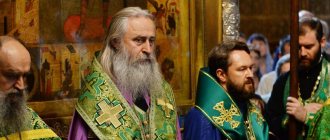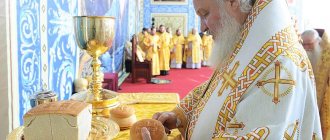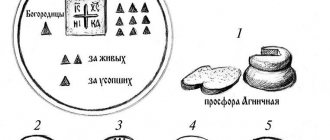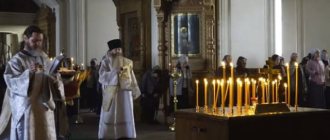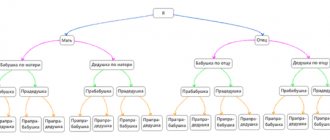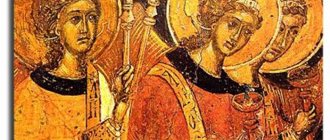For a modern Christian, the Sacrament of Communion is a rare event. But for the consciousness of a true believer, a rare communion with Christ is a punishment. He is burning with the desire to unite with Christ as often as possible, partaking of His Body and Blood - the greatest gift that the Lord has given us.
Lent, with its strict rules, does not provide for the celebration of the full solemn liturgy during the week, and, accordingly, the sacrament of the Eucharist. This required a special service at which believers could receive communion.
What is the Liturgy of the Presanctified Gifts
First, this service is not a liturgy in the full sense of the word. It lacks the Eucharistic canon. In essence, this is Vespers with the rite of Holy Communion. The Holy Gifts are prepared for her at the full liturgy (St. John Chrysostom or St. Basil the Great).
Origin of the phrase
The name of the Presanctified Liturgy comes from the fact that the Body and Blood of Jesus Christ in the form of bread and wine, with which believers must partake, are prepared, transubstantiated, and consecrated in advance. And the purpose of this service is to prepare people for Their acceptance.
Meaning of the concept
Liturgy translated from Greek means common cause. This is the main worship service of the Orthodox Church. The main purpose of this service is the Eucharist (Greek thanksgiving), i.e. communion with the Body and Blood of Christ, experiencing the Last Supper. Presanctified - consecrated in advance (meaning Holy Communion).
What is the difference?
Already from the name of the service it is easy to understand that the Bloodless Sacrifice is not offered at it. At such a service they partake of the pre-consecrated Body and Blood of Christ. The Holy Gifts are usually prepared at the last full Liturgy on Sunday. Therefore, during everyday services, proskomedia (remembrance of the living and the dead with the removal of particles from the prosphora) is not performed. Therefore, there is no need to file a note against it.
The main purpose of the Liturgy of the Presanctified Gifts is to provide communion to those who for some reason were unable to receive communion over the weekend. You need to know that at this service only those who are able to swallow the consecrated particle are suitable for the Holy Chalice. For this reason, infants are not given communion there.
Historical reference
Historically, this service is attributed to St. Gregory the Divine, a Pope who lived in the seventh century. In fact, it existed before, but in different variations. St. Gregory brought to the Roman Church ancient rituals that had been preserved in the East, including this divine service.
The emergence and development of liturgy
The performance of this service on the days of the Holy Pentecost (except for Saturday, Sunday and the Feast of the Annunciation) was approved at the Trullo Council of 691-692.
But at the council its completion was only officially confirmed, which means that it already existed. It is impossible to talk about the exact date of its appearance because the sequence of services developed over time.
The basis of this service—preparing the Holy Gifts in advance—appeared in the first centuries. The holy martyr Justin (beginning of the second century) wrote that Communion was prepared, and the deacons carried it to those who could not be at the service.
The Presanctified Liturgy appeared as a separate service when Great Lent began. And since during the week the solemn liturgies of St. John Chrysostom and Basil the Great were not celebrated; there was a need to prepare Holy Communion in advance, so that it would be possible to receive communion not only on Saturdays and Sundays.
Current situation
The Liturgy of the Presanctified Gifts should be celebrated in the evening at the ninth hour (according to Byzantine time), i.e. at three in the afternoon. But most often it is done in the morning.
The days on which this service is performed are as follows:
- on Wednesdays and Fridays of Lent, except for the Feast of the Annunciation;
- on Thursday of the fifth week;
- on Monday, Wednesday and Tuesday of Holy Week;
- on the Polyeleos holidays: the first and second Finding of the Head of John the Baptist (February 24, Art.), 40 Martyrs of Sebaste;
- temple holidays.
Origin of service
Mentions of the Presanctified Liturgy as a Lenten service are found already in the 6th century. What is the reason for its occurrence? As you know, fasting is a time of sorrow and contrition for one’s sins. Liturgy is always a holiday, a celebration, which is why it was also called Easter in ancient times.
In order not to disturb the general repentant mood of Lent, on the one hand, and not to deprive oneself of communion for a week, on the other, such a touching service was invented. We can say that the main pathos and feature of the service is the longing for communion. The presence of such a service in the church charter is proof that the early Christians received communion frequently.
There is an opinion that the Presanctified Liturgy arose from the ancient tradition of self-communion of Christians at home. It especially spread during times of persecution and was later adopted by hermit monks living in the desert.
Saint Justin the Philosopher mentions that deacons carried the Holy Gifts home to those Christians who, for some reason, could not receive communion in church.
This practice existed until the 15th century, and today, unfortunately, it has been completely lost. But in those distant times, self-communion of the laity was a common and everyday phenomenon, for which there is much evidence.
How is the service going?
The text of the service differs in many ways from the usual one.
At the beginning the priest says:
“Blessed is the Kingdom of the Father and the Son and the Holy Spirit, now and ever and unto ages of ages.”
Vespers follows:
- Psalm 103;
- peaceful litany;
- kathisma (which is divided into 3 parts, after each there is a small litany).
At this time, in the altar, the priest transfers the Holy Gifts from the throne to the altar, accompanying this with incense.
Further:
- “The Lord cried out” with the corresponding stichera (at the same time the incense of the temple is performed);
- small entrance;
- reading of proverbs (preceded by prokeemnas).
After the second paremia, the royal doors open and the priest with a candle and censer facing the people says:
“The light of Christ enlightens everyone.”
After the third proverb, excerpts from Psalm 140 “Let my prayer be corrected...” are sung. This is followed by the prayer of Ephraim the Syrian “Lord and Master of my life,” accompanied by three prostrations to the ground.
After this, the order of the liturgy follows, starting with a special litany with petitions for those who should begin holy Baptism (catechumens). This is due to the fact that in the ancient Church Baptism was performed on Easter or Bright Week. At this moment, the unbaptized went out into the vestibule of the temple and did not participate in further worship. Therefore this part is called the Liturgy of the Faithful .
This is followed by the Great Entrance, which is preceded by a special chant:
“Now the Heavenly Powers serve with us invisibly, behold, the King of Glory enters: behold, the secret Sacrifice has been completed.”
The priest makes his entrance holding the paten over the chalice and says:
“Let us draw near by faith and love, that we may be partakers of eternal Life. Alleluia, alleluia, alleluia."
As stated above, there is no Eucharistic canon, which consists of prayers invoking the Holy Spirit for the offered Gifts.
Then follows:
- Prayer of Ephraim the Syrian with bows.
- Litany of petition.
- Our Father.
- Supreme prayer.
- The cry of “Holy of Holies.”
The clergy take communion at the altar, after which they give communion to the faithful. At the end, a special prayer behind the pulpit is read.
Orthodox Life
Many will agree that one of the most beautiful services of Great Lent is the Liturgy of the Presanctified Gifts. But since it is performed only during Lent, very few people are thoroughly familiar with it.
Let's look at some interesting features of this service.
Everyone knows that the composition of this service is attributed to St. Gregory the Dvoeslov, Pope of Rome. His name is mentioned at the conclusion of this service. At the end of the prayers of thanksgiving for Holy Communion, a troparion is read to him. Disputes about whether he or not he was the compiler of this service have not subsided among scientists for many years, but it is known for certain that in Rome, where St. Gregory the Dvoeslov served as bishop, around his time a service with the communion of the Presanctified Gifts was also established. It was performed (and is performed today by Catholics) only once a year - on Good Friday.
If we have two complete Liturgies - St. John Chrysostom and St. Basil the Great, then the Liturgy of the Presanctified Gifts is one. But it was not always so. There is another service in ancient manuscripts, its authorship is attributed to the Apostle James, the brother of God (not to be confused with the complete Liturgy of the Apostle James, performed in some churches on the day of remembrance of the saint). She was served in Jerusalem and its environs. It has not been included in modern worship. Outside of Orthodoxy, the Liturgy of the Presanctified Gifts is celebrated by the Monophysites - in the Malankara Church (India) and, as mentioned above, by Catholics.
Everyone who attended this service, I think, noticed that it contained many chants from the rite of Vespers. This is not accidental and is due to the fact that in ancient times the Liturgy of the Presanctified Gifts was served in the evening and was added to Vespers, so that after long Lenten services during the day, without eating much more food than usual (from midnight to evening), they could partake of the Holy Mysteries of Christ. Now in the vast majority of churches this Liturgy is performed in the morning, knowing that it is difficult for a modern person to withstand such preparation.
Many also paid attention to the fact that during this service they read passages from the Books of Genesis and Proverbs. This is due to the fact that in Byzantium, fasting was a time for teaching the catechumens, that is, those who wished to be baptized (and everyone was baptized mainly on Holy Saturday). Considering that books were very expensive and only a few could afford to have them at home, the Old Testament began to be read during services in order to teach the catechumens and remind everyone else of the foundations of our faith. After all, the Book of Genesis reveals the Christian understanding of the structure of our world, and the Book of Proverbs contains the foundations of moral life.
The exclamation “The Light of Christ enlightens everyone,” which is uttered by the priest holding a candle between reading Old Testament passages, is also associated with the preparation for the baptism of the catechumens. The holy fathers of antiquity often understood baptism as enlightenment. Even now our Sacrament of Baptism contains the following words: “Thou art justified. You have become enlightened. You are sanctified. You have washed yourself in the name of our Lord Jesus Christ and in the Spirit of our God.” With the exclamation “Light of Christ...” and the image of visible light - a candle catechumen, who must leave the service in a few minutes, they were reminded that they would soon be enlightened by the true Light - Christ, and the faithful present - that they must remember that they were enlightened by God.
One cannot help but recall probably the most touching and memorable hymn of the Lenten Liturgy - the hymn “May my prayer be corrected.” This passage from Psalm 140, which is sung by the singers at the pulpit, is nothing less than the great prokeimenon - four verses from the psalm with a chorus. We are much more accustomed to encountering the prokeimenon before reading the Apostle or the Gospel, but here it is sung in its ancient place. To be convinced of this, it is enough to remember for those who often attend evening services that the great prokeimenon (and this is “The Lord reigns” at every Saturday all-night vigil or “Who is the great God” at the evening service on the days of great holidays) is sung precisely at this place .
If someone regularly attends the Liturgy of the Presanctified Gifts, then they may notice that exactly with the beginning of the second half of Lent (which is Wednesday of the fourth week of Lent), another litany is added to the liturgical rite. It is called the litany of “those preparing for enlightenment” and contains petitions for God to strengthen and guide those who will be baptized. This is due to the fact that it was by this time that the final lists of those intending to be baptized this year were compiled in ancient Constantinople and intensive preparations began. This litany is read until Holy Wednesday - until the very last Liturgy of the Presanctified Gifts of the current year.
At every full Liturgy we hear the Cherubic hymn “
Like the Cherubim,” at the Liturgy of the Presanctified Gifts there is also a Cherubic hymn, but another one: “Now the forces of Heaven serve invisibly with us.” This is one of the most ancient hymns of the Liturgy of the Presanctified Gifts; for the first time we find its full text in the Easter Chronicle of Constantinople under the year 615 or 616.
After the “Now of Power” and the Great Entrance, it is customary for us to close the curtain only halfway, symbolizing that the Liturgy is incomplete. But you need to know that this is a typically Slavic tradition; in Greek practice, they close the entire veil completely.
A notable feature of this service is that the last prayer of the service, the prayer behind the pulpit, is also not the same as at a regular Liturgy. In particular, it contains the following lines: “Grant us, O Blessed One, to fight a good fight, to complete the course of Lent, to maintain undivided faith, to crush the heads of invisible serpents, to appear as conquerors of sin and to reach without condemnation and worship the Holy Resurrection...” Easter is that the goal to which we must appear as conquerors of sin. We have only touched a little on the Liturgy of the Presanctified Gifts, but we have already seen how much meaning it carries. A look at the history of worship always helps to understand it more deeply and thereby participate more actively and consciously in it.
Alexander Adomenas
Photo by Seraphim Rosokha
Question about the author
Traditionally, the author of the Liturgy of the Presanctified Gifts is called Saint Gregory the Dvoeslov. He lived in the 6th century and was Pope. The saint received his nickname from the names of the “interviews and dialogues” he wrote (literally “dialogue” - “double words”). His memory is celebrated on March 25.
But the most interesting thing is that the Holy Pope of Rome most likely was not the compiler of the rite of the Presanctified Liturgy. This is confirmed by recent scientific research. Among the authors of this service, the sources mention the names of Epiphanius of Cyprus, Herman of Constantinople, even Basil the Great. And not once - St. Gregory.
As you know, there is no smoke without fire. Why, after all, is Gregory Dvoeslov so strongly associated with the specific worship of Great Lent? Everything is very simple. This holy man really worked a lot in the field of church services, including in putting the services in order. It is likely that he had the opportunity to streamline and supplement the rite of the Liturgy of the Presanctified Gifts, as well as introduce it into general church use.
Why does the bell ring?
Another notable feature of the Liturgy of the Presanctified Gifts is the mysterious bell. It rings several times in the altar at the most important moments of the service. When we hear the ringing for the first time, we fall to our knees in admiration; when the bell rings again, we stand up. When does it ring?
- When the Holy Gifts are transferred from the throne to the altar. At this time, the Psalter, the third part of the kathisma, is read in the temple.
- After reading the first paremia, the priest takes a censer and a candle, depicting a cross in the air with the censer, and says: Wisdom, forgive me! With this he calls us to special attention. Then the priest turns to the worshipers and, blessing them, says: The Light of Christ enlightens everyone!
The candle symbolizes light; Christ is the Light of the world, in whom all the Old Testament prophecies came true. That is why a candle is lit while reading a passage from the Old Testament. As you can see, all the features of the service have their own deep meaning and symbolism. And nothing prevents us from enjoying this service “live” at least once during Lent.
Watch the video with commentaries on the Presanctified Liturgy here:
Morning Vespers
Why is it more correct to serve the Presanctified Liturgy in the evening? The peculiarity of the service is that it is performed together with Lenten Vespers. If you perform it at a later time of day, some words of prayers and chants will be perceived closer in meaning: “evening sacrifice”, “Quiet Light”, “Let us fulfill our evening prayer to the Lord...”
Vespers is preceded by the service of Lenten hours followed by the Fine Hours (another specific service). After the Lesser Entry of Vespers and the singing of “Quiet Light,” two passages from the Old Testament are read—proverbs. The first passage is from the Book of Genesis about the creation of the world and the Fall, the second passage is from the Proverbs of Solomon.
After reading the first paremia, three singers from the choir (church choir) go to the center of the temple and stand in front of the Royal Doors. Next comes one of the most memorable, soul-penetrating chants of the Liturgy of the Presanctified Gifts. These are selected verses from Psalm 140. In Russian they sound like this:
Let my prayer be directed like incense (fragrant smoke) before Thy face, and the lifting of my hands like the evening sacrifice. God! I appeal to You: hurry to me; listen to the voice of my prayer when I cry to You. Set, O Lord, a guard over my lips, and guard the doors of my mouth. Do not let my heart turn aside to evil words to excuse sinful deeds.
During the singing, everyone present in the church kneels, and the clergy censes in the altar. After this, the prayer of Ephraim the Syrian is said with three prostrations to the ground.


